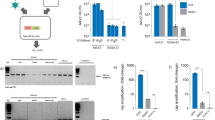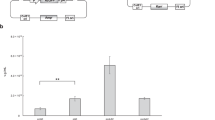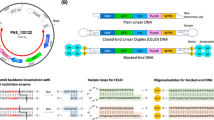Abstract
Retroviral vectors have many favorable properties for gene therapies, but their use remains limited by safety concerns and/or by relatively lower titers for some of the safer self-inactivating (SIN) derivatives. In this study, we evaluated whether increased production of SIN retroviral vectors can be achieved from the use of matrix attachment region (MAR) epigenetic regulators. Two MAR elements of human origin were found to increase and to stabilize the expression of the green fluorescent protein transgene in stably transfected HEK-293 packaging cells. Introduction of one of these MAR elements in retroviral vector-producing plasmids yielded higher expression of the viral vector RNA. Consistently, viral titers obtained from transient transfection of MAR-containing plasmids were increased up to sixfold as compared with the parental construct, when evaluated in different packaging cell systems and transfection conditions. Thus, use of MAR elements opens new perspectives for the efficient generation of gene therapy vectors.
This is a preview of subscription content, access via your institution
Access options
Subscribe to this journal
Receive 12 print issues and online access
$259.00 per year
only $21.58 per issue
Buy this article
- Purchase on Springer Link
- Instant access to full article PDF
Prices may be subject to local taxes which are calculated during checkout




Similar content being viewed by others
References
Cavazzana-Calvo M, Hacein-Bey S, de Saint-Basile G, Le Deist F, Fischer A . Gene therapy of severe combined immunodeficiencies. Transfus Clin Biol 2000; 7: 259–260.
Aiuti A . Advances in gene therapy for ADA-deficient SCID. Curr Opin Mol Ther 2002; 4: 515–522.
Gaspar HB, Parsley KL, Howe S, King D, Gilmour KC, Sinclair J et al. Gene therapy of X-linked severe combined immunodeficiency by use of a pseudotyped gammaretroviral vector. Lancet 2004; 364: 2181–2187.
Miller AD, Wolgamot G . Murine retroviruses use at least six different receptors for entry into Mus dunni cells. J Virol 2004; 71: 4531–4535.
Somia N, Verma IM . Gene therapy: trials and tribulations. Nat Rev Genet 2000; 1: 91–99.
Somia NV, Miyoshi H, Schmitt MJ, Verma IM . Retroviral vector targeting to human immunodeficiency virus type 1-infected cells by receptor pseudotyping. J Virol 2000; 74: 4420–4424.
Hildinger M, Abel KL, Ostertag W, Baum C . Design of 5′ untranslated sequences in retroviral vectors developed for medical use. J Virol 1999; 73: 4083–4089.
Trobridge G, Josephson N, Vassilopoulos G, Mac J, Russell DW . Improved foamy virus vectors with minimal viral sequences. Mol Ther 2002; 6: 321–328.
Zaiss AK, Liu Q, Bowen GP, Wong NC, Bartlett JS, Muruve DA . Differential activation of innate immune responses by adenovirus and adeno-associated virus vectors. J Virol 2002; 76: 4580–4590.
Mikkers H, Berns A . Retroviral insertional mutagenesis: tagging cancer pathways. Adv Cancer Res 2003; 88: 53–99.
Modlich U, Kustikova OS, Schmidt M, Rudolph C, Meyer J, Li Z et al. Leukemias following retroviral transfer of multidrug resistance 1 (MDR1) are driven by combinatorial insertional mutagenesis. Blood 2005; 105: 4235–4246.
Modlich U, Schambach A, Brugman MH, Wicke DC, Knoess S, Li Z et al. Leukemia induction after a single retroviral vector insertion in Evi1 or Prdm16. Leukemia 2008; 22: 1519–1528.
Thornhill SI, Schambach A, Howe SJ, Ulaganathan M, Grassman E, Williams D et al. Self-inactivating gammaretroviral vectors for gene therapy of X-linked severe combined immunodeficiency. Mol Ther 2008; 16: 590–598.
Zychlinski D, Schambach A, Modlich U, Maetzig T, Meyer J, Grassman E et al. Physiological promoters reduce the genotoxic risk of integrating gene vectors. Mol Ther 2008; 16: 718–725.
Yu SF, von Ruden T, Kantoff PW, Garber C, Seiberg M, Ruther U et al. Self-inactivating retroviral vectors designed for transfer of whole genes into mammalian cells. Proc Natl Acad Sci USA 1986; 83: 3194–3198.
Schambach A, Mueller D, Galla M, Verstegen MM, Wagemaker G, Loew R et al. Overcoming promoter competition in packaging cells improves production of self-inactivating retroviral vectors. Gene Ther 2006; 13: 1524–1533.
Kraunus J, Schaumann DH, Meyer J, Modlich U, Fehse B, Brandenburg G et al. Self-inactivating retroviral vectors with improved RNA processing. Gene Ther 2004; 11: 1568–1578.
Schambach A, Bohne J, Chandra S, Will E, Margison GP, Williams DA et al. Equal potency of gammaretroviral and lentiviral SIN vectors for expression of O6-methylguanine-DNA methyltransferase in hematopoietic cells. Mol Ther 2006; 13: 391–400.
Kraunus J, Zychlinski D, Heise T, Galla M, Bohne J, Baum C . Murine leukemia virus regulates alternative splicing through sequences upstream of the 5′ splice site. J Biol Chem 2006; 281: 37381–37390.
Schambach A, Bohne J, Baum C, Hermann FG, Egerer L, von Laer D et al. Woodchuck hepatitis virus post-transcriptional regulatory element deleted from X protein and promoter sequences enhances retroviral vector titer and expression. Gene Ther 2006; 13: 641–645.
Schambach A, Galla M, Maetzig T, Loew R, Baum C . Improving transcriptional termination of self-inactivating gamma-retroviral and lentiviral vectors. Mol Ther 2007; 15: 1167–1173.
Kustikova OS, Modlich U, Fehse B . Retroviral insertion site analysis in dominant haematopoietic clones. Methods Mol Biol 2009; 506: 373–390.
Modlich U, Baum C . Leukemia induction after a single retroviral vector insertion in Evi1 or Prdm 16. Leukemia 2008; 22: 1519–1528.
Loew R, Meyer Y, Kuehlcke K, Gama-Norton L, Wirth D, Hauser H et al. A new PG13-based packaging cell line for stable production of clinical-grade self-inactivating ã-retroviral vectors using targeted integration. Gene Ther 2010; 17: 272–280.
Rampalli S, Kulkarni A, Kumar P, Mogare D, Galande S, Mitra D et al. Stimulation of Tat-independent transcriptional processivity from the HIV-1 LTR promoter by matrix attachment regions. Nucleic Acids Res 2003; 31: 3248–3256.
Goetze S, Baer A, Winkelmann S, Nehlsen K, Seibler J, Maass K et al. Performance of genomic bordering elements at predefined genomic loci. Mol Cell Biol 2005; 25: 2260–2272.
Craig JM, Boyle S, Perry P, Bickmore WA . Scaffold attachments within the human genome. J Cell Sci 1997; 110: 2673–2682.
de Belle I, Cai S, Kohwi-Shigematsu T . The genomic sequences bound to special AT-rich sequence-binding protein 1 (SATB1) in vivo in Jurkat T cells are tightly associated with the nuclear matrix at the bases of the chromatin loops. J Cell Biol 1998; 141: 335–348.
Bode J, Stengert-Iber M, Kay V, Schlake T, Dietz-Pfeilstetter A . Scaffold/matrix-attached regions: topological switches with multiple regulatory functions. Crit Rev Eukaryot Gene Expr 1996; 6: 115–138.
Bode J, Goetze S, Heng H, Krawetz SA, Benham C . From DNA structure to gene expression: mediators of nuclear compartmentalization and dynamics. Chromosome Res 2003; 11: 435–445.
Goetze S, Gluch A, Benham C, Bode J . Computational and in vitro analysis of destabilized DNA regions in the interferon gene cluster: potential of predicting functional gene domains. Biochemistry 2003; 42: 154–166.
Heng HH, Goetze S, Ye CJ, Liu G, Stevens JB, Bremer SW et al. Chromatin loops are selectively anchored using scaffold/matrix-attachment regions. J Cell Sci 2004; 117: 999–1008.
Gasser SM, Laemmli UK . The organisation of chromatin loops: characterization of a scaffold attachment site. EMBO J 1986; 5: 511–518.
Benham C, Kohwi-Shigematsu T, Bode J . Stress-induced duplex DNA destabilization in scaffold/matrix attachment regions. J Mol Biol 1997; 274: 181–196.
Bode J, Benham C, Knopp A, Mielke C . Transcriptional augmentation: modulation of gene expression by scaffold/matrix-attached regions (S/MAR elements). Crit Rev Eukaryot Gene Expr 2000; 10: 73–90.
Piechaczek C, Fetzer C, Baiker A, Bode J, Lipps HJ . A vector based on the SV40 origin of replication and chromosomal S/MARs replicates episomally in CHO cells. Nucleic Acids Res 1999; 27: 426–428.
Chen Y, Zhao M, Li ZP, He ML . The function of the nuclear matrix attachment region of silkworm rDNA as an autonomously replicating sequence in plasmid and chromosomal replication origin in yeast. Biochem Biophys Res Commun 2002; 299: 723–729.
Jenke BH, Fetzer CP, Stehle IM, Jonsson F, Fackelmayer FO, Conradt H et al. An episomally replicating vector binds to the nuclear matrix protein SAF-A in vivo. EMBO Rep 2002; 3: 349–354.
Lipps HJ, Jenke AC, Nehlsen K, Scinteie MF, Stehle IM, Bode J . Chromosome-based vectors for gene therapy. Gene 2003; 304: 23–33.
Conese M, Auriche C, Ascenzioni F . Gene therapy progress and prospects: episomally maintained self-replicating systems. Gene Ther 2004; 11: 1735–1741.
Klehr D, Maass K, Bode J . Scaffold-attached regions from the human interferon beta domain can be used to enhance the stable expression of genes under the control of various promoters. Biochemistry 1991; 30: 1264–1270.
Schubeler D, Mielke C, Maass K, Bode J . Scaffold/matrix-attached regions act upon transcription in a context-dependent manner. Biochemistry 1996; 35: 11160–11169.
Zahn-Zabal M, Kobr M, Girod PA, Imhof M, Chatellard P, de Jesus M et al. Development of stable cell lines for production or regulated expression using matrix attachment regions. J Biotechnol 2001; 87: 29–42.
Harraghy N, Gaussin A, Mermod N . Sustained transgene expression using MAR elements. Curr Gene Ther 2008; 8: 353–366.
Girod PA, Nguyen DQ, Calabrese D, Puttini S, Grandjean M, Martinet D et al. Genome-wide prediction of matrix attachment regions that increase gene expression in mammalian cells. Nat Methods 2007; 4: 747–753.
Galbete JL, Buceta M, Mermod N . MAR elements regulate the probability of epigenetic switching between active and inactive gene expression. Mol Biosyst 2009; 5: 143–150.
Yang S, Delgado R, King SR, Woffendin C, Barker CS, Yang ZY et al. Generation of retroviral vector for clinical studies using transient transfection. Hum Gene Ther 1999; 10: 123–132.
Emerman M, Temin HM . Genes with promoters in retrovirus vectors can be independently suppressed by an epigenetic mechanism. Cell 1984; 39: 459–467.
Weber E, Anderson WF, Kasahara N . Recent advances in retrovirus vector-mediated gene therapy: teaching an old vector new tricks. Curr Opin Mol Ther 2001; 3: 439–453.
Karlen Y, McNair A, Perseguers S, Mazza C, Mermod N . Statistical significance of quantitative PCR. BMC Bioinformatics 2007; 8: 131.
Acknowledgements
We thank Dr Odile Cohen-Haguenauer for comments and improvements on the paper. This work was supported by grants from the Network of Excellence in Gene therapy (CLINIGENE-NOE) LSHB-CT-2006-018933 of the European FP6 program, the Swiss Commission for Technology and Innovation, Selexis SA, and by the Etat de Vaud.
Author information
Authors and Affiliations
Corresponding author
Ethics declarations
Competing interests
Dr Buceta's work was funded by a European Network of Excellence and by Selexis SA, and she has obtained an employment at this company after the completion of this work. Dr Mermod is a cofounder and owns stocks of the company. Dr Kostic and Dr Arsenijevic declare no potential conflict of interest.
Additional information
Supplementary Information accompanies the paper on Gene Therapy website
Supplementary information
Rights and permissions
About this article
Cite this article
Buceta, M., Galbete, J., Kostic, C. et al. Use of human MAR elements to improve retroviral vector production. Gene Ther 18, 7–13 (2011). https://doi.org/10.1038/gt.2010.115
Received:
Revised:
Accepted:
Published:
Issue Date:
DOI: https://doi.org/10.1038/gt.2010.115
Keywords
This article is cited by
-
Distance effect characteristic of the matrix attachment region increases recombinant protein expression in Chinese hamster ovary cells
Biotechnology Letters (2020)
-
Enhanced transgene expression using two β-globin MARs flanking expression cassettes in stably transfected CHO-K1 cells
3 Biotech (2019)
-
Use of a new genetic element to improve expression level of cell lines for recombinant protein production
BMC Proceedings (2015)
-
Distance effect of matrix attachment regions on transgene expression in stably transfected Chinese hamster ovary cells
Biotechnology Letters (2014)
-
Co-expression of two fibrolytic enzyme genes in CHO cells and transgenic mice
Transgenic Research (2013)



